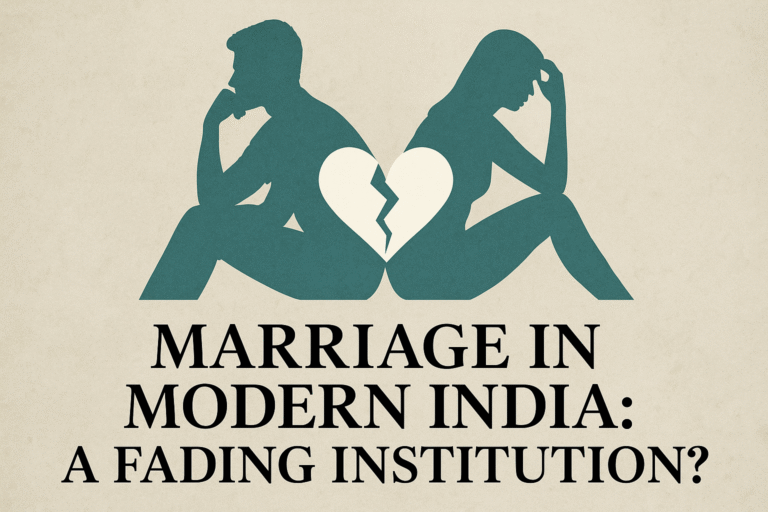Marriage in Modern India: A Fading Institution?
In recent years, a spate of high-profile crime cases involving toxic relationships, domestic violence, and dowry harassment has begun reshaping how young Indians perceive the institution of marriage. Cases like the much-hyped Sonam–Raja Raghuvanshi incident from Indore have received intense media scrutiny and gone viral on social media, amplifying fears related to trust, personal safety, and emotional well-being. As a result, an increasing number of young people are questioning whether marriage—once viewed as sacred, lifelong bond—is still worth the emotional and legal risks it often seems to carry. Recently, I asked my 35-year-old nephew—successful, financially stable, and traditionally “marriageable”—about his thoughts on settling down. Instead of answering directly, he responded with a counter-question: “Do you people want me to get into all this instead of leading a peaceful life?” He went on to cite a series of disturbing cases, illustrating the growing perception that marriage today can come with unforeseen, often overwhelming consequences. A few young women I spoke to also responded with noticeable hesitation and ambivalence when asked about their marriage plans. Their unease was not about relationships per se, but about the uncertainty and risks surrounding the institution of marriage itself.
A recent survey found that 42% of Indians aged 26 to 40 do not want to get married. That’s a telling number. Many young adults’ express anxiety about the potential emotional toll, commitment pressure, and especially the legal vulnerabilities that marriages can bring. Cases involving exorbitant alimony demands and lengthy legal disputes have contributed to a rising sense of fear. In one case, a wife demanded ₹500 crores in alimony from her US- based husband, involving the extended families in a prolonged and bitter legal battle. In another case, the Supreme Court settled the matter for ₹12 crores. Such headlines fuel the perception that marriage can expose individuals—and their families—to serious legal and financial consequences. It was once believed that love marriages offered a better alternative to arranged ones, driven by mutual choice rather than obligation. But this belief, too, is being challenged. Recent cases have shown that love marriages are not immune to the very same issues—family interference, trust breakdowns, false allegations, or incompatible expectations. Whether arranged or chosen, marriage now appears to many as a complex undertaking with increasingly unpredictable outcomes.

Many young people today prioritize mental peace, personal growth, and professional aspirations. Marriage, instead of being a support system, is often seen as a source of compromise or potential instability. The younger generation is also exposed to alternative relationship models and evolving lifestyles through global media and lived experiences. Failed marriages in their own families or social circles further reinforce their skepticism. In this environment, staying single is not a rejection of love, but a conscious choice to avoid risk and maintain control over one’s life. What’s happening in India today reflects a broader cultural shift. Practices like delayed or no marriage, once seen as Western trends, are gaining ground in Indian society. While not universal, the hesitation toward marriage is no longer confined to a fringe mindset. For many, the fear of commitment is rooted not in immaturity but in genuine concerns—about compatibility, social expectations, personal freedom, and legal entanglements. Yet, it’s also important to recognize that marriage still holds meaning for many. The desire for companionship, stability, and shared growth continues to attract people to this institution. Ultimately, marriage must be seen for what it is: a deeply personal choice, not a cultural obligation. It is perfectly acceptable to not get married, just as it is to seek a meaningful partnership through marriage. What matters is that the decision aligns with one’s values, goals, and vision for life. As societal norms evolve, so too should our understanding of fulfillment and happiness, whether found within or outside the bounds of marriage.